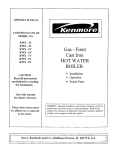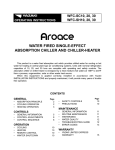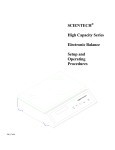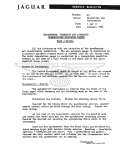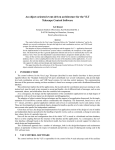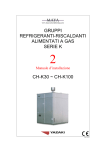Download Yazaki Aroace WFC-SH30 Specifications
Transcript
WFC- SC(H) Chiller & Chiller-Heater 2 Installation WFC-SC(H)10, 20,30 & 50 Version 11-1 -1- WFC- SC(H) Series .Installation Contents Page 1. General Information 1.1 Precautions 1.2 Receiving 1.3 Unit data plate ...................................... ..................................... ...................................... 2 2 2 ..................................... ..................................... 3 3 .................................... .................................... .................................... .................................... 3 4 4 5 .................................... .................................... .................................... .................................... 7 9 10 11 5.1 Electrical system diagram 5.2 Electrical connection of auxiliary equipment........................... 5.3 Junction box electrical wiring .................................... 5.3.1 Location of Junction box 5.3.2 Inside of Junction box wiring 5.4 Remote switching .................................... 5.4.1 Location of Control box (CB) .................................... 5.4.2.How to wire (remote switch) .................................... 5.4.3 Position of RUN-REMOTE-STOP Switch 5.5 Condition output signal ……………………… 5.5.1 How to wiring ( condition output signal ) 12 12 13 13 14 15 15 15 16 17 17 2. Handling 2.1 Rigging 2.2 Access clearances 3. Place of Installation 3.1 3.2 3.3 3.4 Location Minimum Maintenance clearances Foundation Placement 4. Piping 4.1 4.2 4.3 4.4 General Chilled-hot water piping Cooling water piping Heat medium circuit 5. Electrical Wiring 6. Water Quality 6.1 General 6.2 Quality limits table ................................... ................................... 18 18 ................................... 19 ……………………… ……………………… 19 19 7. Ambient temperature 7.1 General 8 Commissioning Request 8.1 General 8.2 Start-up check list -2- WFC- SC(H) Series .Installation General Information. 1.1 Precautions The chiller-heater should be installed by trained and qualified personnel who are familiar with absorption machinery. All precautions in these instructions, on tags and on labels attached to the chiller-heater must be strictly observed to ensure safety of personnel and continuance of the warranty validation. Each absorption chiller-heater has been evacuated, charged with lithium bromide and water, and tested prior to leaving the factory. After the equipment has been installed, a Yazaki authorized service agent will check the installation and supervise the initial commissioning of the machine. It is important to note that the warranty applying to the Yazaki chiller-heater will become void if the following restrictions are not fully observed. 1. Do not open any service valves because such action will result in loss of vacuum. 2. Always handle the equipment with care and in an upright position, do not drop or subject the machine to side impact. 3. Do not attempt to start the system without supervision from a Yazaki authorized service agent. 1.2 Receiving When the absorption chiller-heater is delivered to site, inspect it for transit damage. Should any damage have occurred, do not proceed with the installation until the Yazaki distributor has been notified and instruction to continue has been obtained. 1.3 Unit Data Plate Check that the model number, electric voltage of the chiller-heater are consistent with the system design and services available at site before proceeding with installation. All this information is displayed on the Unit Data Plate located on the front panel of the machine. Aroace Hot Water Energized Chiller-Heater Technical Specifications Model Type Cooling (kW) Outlet temperature Cooling (°C) Chilled-hot water Flow rate (l/sec) Evaporator pressure loss (kPa) Inlet temperature (°C) Cooling water Flow rate (l/sec) Absorber / Condenser pressure loss (kPa) Inlet temperature (°C) Outlet temperature (°C) Heat medium water Flow rate (l/sec) Generator pressure loss (kPa) Power supply (VAC/ Ph/ Hz) Electrical Consumption IPX4 IP Serial No. Manufacturing Date YAZAKI Corporation Hamamatsu Japan Manufacturer Distributor Capacity 7.0 31 88 83 400 /3 / 50 -3- WFC- SC(H) Series .Installation 2. Handling 2.1 Rigging Remove the crate and wooden base from the absorption chiller-heater. Lift the machine using a wire rope and eye-bolts (eye bolts provided with the chiller-heater as illustrated in figure 1). The dry weight and overall dimensions are detailed in section 1 Specifications of this manual. Care should be taken throughout to avoid damage to panels and piping connections – always lift in a vertical manner. Figure 1 2.2 Access Clearances Properly plan to ensure an accessible route to the place of installation before moving the chiller-heater. If it is not possible to use a crane for lifting, a fork lift truck may be utilized. In the event a crane or forklift cannot be used and the machine must be manhandled into position, minimum dimensions for maneuver are shown in figure 2. Figure 2 Access Clearance Table (mm) Dimension A B C D WFC-SC10 WFC-SH10 2,365 1,600 1,600 1,600 WFC-SC20 WFC-SH20 WFC-SC30 WFC-SH30 2,490 1,905 1,905 1,905 2,235 2,235 2,235 WFC-SC50 2,565 2,145 2,420 2,420 3. Place of Installation 3.1 Location The Yazaki absorption chiller-heater units have a weatherproof cabinet suitable for indoor or outdoor installation. Select the location for the chiller-heater with due consideration to the position and proximity of the cooling tower, and air handling equipment. Particular attention must be paid to accessing the absorption machine for -4- WFC- SC(H) Series .Installation service, the Yazaki chiller-heater will not perform correctly on a continuous basis without proper maintenance. Furthermore, always avoid placing the cooling tower at a lower level than the chiller-heater. Such designs invariably lead to problems with maintaining pumping stability. 3.2 Minimum Maintenance Clearances The minimum space and clearance requirements shown in figure 3 must be provided around each chiller-heater unit to facilitate installation, commissioning and procedures in maintenance. The clearances shown in the table below apply to the CHK 30 through to the CHK100 machines. If the system is a multi-module configuration where chillerheaters will be placed sideby-side, the clearances recommended must still apply. If the recommended service clearances cannot be provided as indicated, the chiller-heater should not be installed. Figure 3 Table of Clearances Installation Area Model WFC-SC(H) 10 20 30 50 A 3,575 3,540 3,780 4,060 B 2,885 2,860 3,180 3,185 Maintenance Clearances Front C 1,000 1,000 1,000 1,000 Back D 1,000 1,000 1,000 1,000 Left side E 700 700 700 700 Right side F 700 700 700 700 3.3 Foundation Mount the absorption chiller-heater on a level foundation constructed of noncombustible materials, capable of supporting the operating weight of the machinery. This particularly applies to roofs, if that is where installation is contemplated. Be sure the roof is able to support the chiller-heater, cooling tower, pumps and associated piping (refer Section 1. Specifications for details). It is additionally important that, if the equipment is to be placed on the roof of a building, it should be located in a well drained area and at least two meters from the edge. A suitable -5- WFC- SC(H) Series .Installation platform or walkway should be built such that the chiller-heater, cooling tower and electrical apparatus can be safely and conveniently serviced. L e v e l s u rfa c e If the chiller-heater is to M o rta r be placed outdoors at soil level, a proper C o n cre te Figure 4 concrete base, with dimensions indicated in F o u n d a t io n r o c k figure 3 and constructed following the example of figure 4, is necessary. All aspects of foundation and support computations must be in accordance with local codes. Should the foundation prove inadequate, the chiller-heater, over time, will tilt causing the proper distribution of working fluids internal to the machine to be impaired; poor cooling performance will result. 3.4 Placement < For SC(H)10 ,20, 30 > When the chiller-heater is finally positioned on its foundation, be sure that the mounting bolts are properly located in the slots of the supporting plates (figure 5). Figure 5 A lifting bar must be used to lift the machine sufficient to insert packing shims under the supporting plates as shown in figure 6. Leveled by mounting bolt Hydraulic jack with claws Figure 6 Slide each skim in as far as possible making sure it locates the mounting bolt. Rotate each skim so that they fit uniformly under the fixing plate of the chiller/heater. -6- WFC- SC(H) Series .Installation < For SC50 > Fix the chiller with fixing plate and anchor bolt. The fixing plate and the anchor bolts are delivered as chiller accessory(Refer fig7) Lift the chiller with a hydraulic jack and level the chiller with the leveling bolt. Base plate to be under the leveling bolt. (Refer fig8) WFC M20 Bolt & washer (Standard accessory) Adjusting bolt (Standard accessory) Washer (Provided by the customer) Fixing plate (Standard accessory) Base plate (Standard accessory) Figure 7 Concrete Foundation Hydraulic jack with claws Insert Base plate Figure 8 Leveled by adjusting bolt < Common > A spirit level must be used to monitor level as shims are inserted. Level reference bars are provided on the upper vessel portion of the chiller-heater. The spirit level must be placed on these as indicated in figure 9. to obtain longitudinal and transverse level. Should the installation comprise more than one chiller-heater located sideby side, it is important that all machines be individually level and level with respect to each other. It is of further Figure 9 importance that all machines are leveled before any piping connections are attempted Adjust the chiller level to be within 2/1000 front/back and side to side horizontal. WFC- SC(H) Series .Installation -7- 4. Piping 4.1 General After leveling the chiller-heater and cooling tower, the chilled-hot water piping, cooling water piping and heat medium piping can be installed. All pipes must be installed and connected to the machine ensuring that complete access for service is provided and that all panels, including the top panel, of the chiller-heater can be easily removed. Failure to observe this vital requirement will lead to severe compromise in commissioning the machine and in future attempts to service the machine. Adequately support and brace the piping independently of the chiller-heater to avoid strain on the piping connections. Do not secure electrical conduit to any part of the machine. Provide thermometer wells at each inlet and outlet relatively close to the machine for measurement of water temperatures during commissioning and maintenance procedures. All piping should be properly aligned and graded to a drain valve to permit complete drainage of the system. Properly located air vents should be provided so that the system can be conveniently filled with water. It is particularly emphasized that access with large pieces of service equipment to the rear of the machine will be required during the life of the chiller-heater. Accordingly, it is recommended that the cooling water and chilled-hot water piping to each machine should be by means of droppers or risers from overhead manifold pipe runs. Insulation providing a proper vapor barrier is recommended on all pipe work, valves and pumps transporting the chilled water. If the chiller-heater is installed outdoors, cladding of the insulation must be provided to combat weathering and the effects of UV. Before making final connections to the chiller-heater, the piping must be flushed with clean water to remove debris. Figure 8 illustrates a typical system design. -8- WFC- SC(H) Series .Installation Typicalpiping pipingsystem system diagram Figure 10 Typical diagram WFC-SC10 ,SH10 Cooling Tower Air vent *1 *4 Air vent P P Heat medium *5 P for Chemical washing P P Air vent *3 P P P P *2 Chilled water Cooling water for Water Chemical supply Drain Drain *6 *6 washing WFC-SC20 ,SH20 WFC-SC30 ,SH30 WFC-SC50 Cooling Tower *1 Air vent *4 Air vent P P Heat medium *5 P for Chemical Air vent washing *3 P P P P for Water Chemical supply Symbol P *2 Chilled water Cooling water Drain P washing Drain Drain *6 *6 Part name Thermometer Well Symbol P Part name Pressure Gauge ( 0-1.5 MPa ) Circulation Pump 3 way valve Flexible Joint Strainer Manual Valve Check Valve *1.Except absorption machine (chain line) must be supplied externally by others. *2.The strainer should install upstream of the pump to protect pumps from contamination. *3.The 3 way valve should be installed where the heat medium pump is under separate control. *4 and *5. Pressure drop adjust by manual valve and pressure gauge, the pressure drop will not to change by 3 way valve opening. *6.Use in case of repairing the components (pumps etc.) or drain the water in winter time etc. *7.Do not exceed 588 kPa in the water & heat medium circuit! -9- WFC- SC(H) Series .Installation 4.2 Chilled-Hot Water Piping Water supply and accommodation of expansion of the chilled water circuit is afforded by either an open cistern or closed expansion tank with check/pressure reducing valves as shown in figure 11. O p en S ys tem C lo sed S ystem R e lie f v a lv e C ist e rn W a t er s u p p ly W a t er s u p p ly 10 0 0 m m M i n im u m C h e c k / r e du c i n g v a lv e E xp a n s io n ta n k F an c o il F an c o il Figure 11 C h il ler H e a t er C h ill er H e a t er C h illed -h o t water pum p C h illed -h o t water pum p Caution. Do not install any valves in the expansion pipeline Plan piping with a rising grade of 1/200. And where high points exist in the piping circuit, install purge valves to expel trapped air. Valve & Thermometer Wells Thermometer wells Manual vent valve Balance valve Stop valve ChillerHeater Caution. Chilled-hot water pump Drain valve Figure 12 Do not exceed 588.4kPa in the chilled-hot water circuit WFC- SC(H) Series .Installation - 10 - A balance valve should be installed in the chilled-hot water outlet and a stop valve should be installed in the chilled-hot water inlet. Both valves along with thermometer wells should be placed in close proximity to the chiller-heater, refer figure 12. After thoroughly testing for leaks, insulate the piping circuit ensuring an adequate vapor barrier is obtained. Be sure the insulation allows proper access to all thermometer wells and hand valves. Be also sure that the chiller-heater panels are not restricted by the insulation. If the equipment is installed outdoors and subject to freezing ambient conditions, trace heating of the pipes under the insulation may be considered. If glycol solutions are contemplated, it is important that inhibitors are in solution to protect copper tubes internal to the machine. It is further most important to understand that cooling capacity of the chiller-heater will be degraded as concentrations of the glycol solutions increase – it must be noted that there is limited flow rate increase allowance for the chilled- hot water circuit. 4.3 Cooling Water Piping Cooling water to the absorption chiller-heater is required at a temperature of 31°C or less during cooling operation. It is also imperative that cooling water less than 24°C should not be supplied to the chiller-heater for prolonged periods.(longer than 30 minutes). If such contingency is likely to occur, a mixing valve facility must be installed as illustrated in figure 13. It is also of particular importance to observe that the cooling flows in a parallel fashion through the WFC-SHC20 & SCH30 machines – dissimilar to the WFCSCH10 which flows in parallel. Attention must be paid to the instruction label on the machine with respect to the sizing of the transfer pipe on the cooling water inlet. Wherever possible, install the cooling tower at the same level or higher than the chiller-heater. If it is not possible, give careful consideration to the prevention of drain-back and loss of Mixing valve cooling water due to overflow at the tower. Such matters should have been given prior Cooling Tower consideration by the Chillerdesign engineer along Heater with proper facility to prevent damage to the cooling tower fill media as a result of daily, frequent mode change-over of the Drain valves Check valve Cooling water chiller-heater. pump F Figure 13 - 11 - WFC- SC(H) Series .Installation A balance valve should be installed in the cooling water inlet and a stop valve installed in the cooling water outlet. Both valves should be placed in close proximity to the chiller-heater along with thermometer wells for temperature measurement. Additionally, drain (flush) valves should be installed between the balance/stop valves and the machine to allow chemical washing of the absorber-condenser coils (see figure 14) Valves & Thermometer Wells Thermometer wells Balance valve Flush valve Stop valve ChillerHeater Flush valve Cooling water pump If it is indicated that none of the aforementioned matters have been adequately catered for, the authorized Yazaki distributor should be contacted for advice. Do not ignore these contingencies; operating the machine without proper safeguards for both the cooling tower and the chiller-heater will void the chiller-heater warranty. Caution. Figure 14 If the cooling water circuit is a closed system, Do not exceed 588.4kPa 4.4 Heat Medium Piping The heat medium pipe work will most likely be a closed system. Accordingly, since temperature of the heat medium may operate as high as 95°C, with a standard inlet 88°C, care should be taken with the expansion device. All considerations with respect to hand valves in the other water circuits also apply to the heat medium circuit. Depending on the type of system used to source the hot water to operate the chillerheater, a diverting valve in the heat medium circuit may be required. Should the decision be made to use a three way valve, the approach to control outlined in the following electrical circuit should be adopted. Caution. Do not exceed 588.4kPa in the heat medium circuit of the absorption chiller-heater - 12 - WFC- SC(H) Series .Installation 5. Electrical Wiring. 5.1. Electrical system diagram Figure 5-1-1 illustrates a typical electrical system diagram. Refer following section for wiring details. Figure 5-1-1 Cooling Tower Fan Cooling Water Pump Chilled / Hot Water Pump Absorption Machine Control Board *1 Pump control *3 Heat Medium Pump Cooling water Switch *4 Heat Medium 3 way Valve Emergency Switch Internal Control Box M Junction box Pump & Fan interlock For Heat Medium Control *2 AC400V 3ph 50Hz Electrical source AC230V 50Hz 1ph Remote operation & C/H mode Changeover Over current breaker Electrical source AC400V 3ph 50Hz Vacuum Pump Status signal *1.Exept absorption machine (chain line) must be supplied externally by others. *2.AC 230V 50Hz 1ph. power consent is required for maintenance (vacuum pump operation). *3.The 3 way valve control can be used in situations where the heat medium pump (P3) is under separate control. *4. Emergency switch (Power shut down switch) must be installed to Control Board. 5.2. Electrical connection of auxiliary equipment All connection according to figure 5-2-1 must be supplied externally by others. 24VAC L1 L2 THR1 .L3 THR2 THRF THR3 LMT1 RT1 RT2 R PE MC1 MC2 MCF THR1 THR2 THRF U1 V1 W1 U2 V2 W2 PE P1 chilled water pump UF VF WF P2 CTF MC1 RT2 MC2 RTF MCF RT3 MC3 ( RT3 ) RTF RT3 R RTV MC3 THR3 SW1 U3 V3 W3 PE PE RT1 PE P3 1 3way valve P SW2 SWF CP SW3 SWV P3A ( P3A ) CM1 Note.6 cooling water cooling tower heat medium pump pump fan CTS Note.4 Do not exceed 24VAC,60VA In case of using 3 way valve ( Note.6 ) Figure 5-2-1 (Typical connection ) Connect to Junction Box (Note.5) Note 1. All conductors must be from copper material. Note 2. All circuits except power supply are low voltage. Note 3. All wiring must comply with local and national electrical code and regulation. Note 4. Cooling water switch (CTS) in sump of cooling tower use switch with maximum contact rating of 24VAC ,1.2VA(60VA). Note 5. The symbols shown in Figure 5-2-1 as P,CP,P3A,CM1,3,4,5,6,CM2 are connect to terminals located in Junction box (section 5-3.). Note 6.The 3 way valve control can be used in situations where the heat medium pump (P3) is under separate control LTM1 is limit switch of 3 way valve. 3 4 5 6 CM2 - 13 - WFC- SC(H) Series .Installation 5-3. Junction box electrical wiring 5.3.1 Location of Junction box Junction box is located left bottom of the Chiller (refer to figure 5-3-1a.) <WFC-SC (H) 10, 20, 30 > Figure 5-3-1a (SC (H) 10, 20 and 30) Junction box <WFC-SC50> Junction box is located rear bottom of the Chiller (refer to figure 5-3-1b.) Figure 5-3-1b (SC50) Junction box - 14 - WFC- SC(H) Series .Installation 5.3.2. Inside of Junction box wiring In the Junction box there is a noise filter and some connecting terminals as figure 5-3-2. Note1. All conductors must be from copper material. Note2. All wiring must comply with local and national electrical code and regulation. Figure 5-3-2 Noise filter Extra control signal output terminal connecting terminal Error signal input terminal 1 2 3 4 5 6 7 8 COM2 S3 S4 ・Connect the conductor by adjusting the symbol (3,4,5,6,CM2) with figure 5-2-1 . L1 L2 P CP P3A P3B CTF CM1 L3 ・These are input terminal to the chiller. ・Attention! You must not give any voltage on to these terminals. power supply terminal Control signal output terminal ・Connect the 400VAC 3phase 50Hz power ・Connect the conductor by adjusting the supply. Connect the ground conductor to PE. ・Circuit breaker and over -current protection must be supplied externally by others. ・These are output terminal from the chiller . ・Attention! symbol (P,CP,P3A,CM1) with figure 5-2-1 . Do not exceed 24VAC, 60VA as shown in Figure 5-2-1. Terminal marking L1, L2, L3,PE PE P CP P3A P3B CTF CM1 1 2 3 4 5 6 7 8 CM2 S3, S4 Description 400VAC 3phase 50Hz primary power supply Ground line Output control signal to chilling/heating water pump Output control signal to cooling water pump Output control signal to heat medium pump (normal open) Output control signal to heat medium pump (normal close) (Option) Output control signal to cooling tower fan (Option) Output signal common circuit Not Use Not Use Error signal from chilling/heating water pump Error signal from cooling water pump Error signal from cooling tower fan Error signal from heat medium pump Not Use Not Use Error signals common circuit Requirement heat medium output signal (Option) - 15 - WFC- SC(H) Series .Installation 5.4. Remote switching If remote operation is required, make the connection according to the following procedure. 5.4.1. Location of Control box (CB) The CB is located behind the front panel as figure 5-4-1 (The sample figure is WFCSC30) Control panel CB Take off the 2 screw to open the cover Figure 5-4-1 Take off the front panel 5.4.2. How to wire (remote switch) Connect the dry contact signal according to Figure 5-4-2. Figure 5-4-2 ( typical connection ) Attention! You must not give any voltage on to these terminals Inside of CB Terminal marking A B C D E F G H I Description Not used Not used Input signal for absorption machine operate Input signal for absorption machine stop Input signal common circuit Not used Not used Not used Not used WFC- SC(H) Series .Installation 5.4.3. Position of RUN-REMOTE-STOP Switch Adjust the "Run-Remote-Stop switch" to the position of the Remote. Figure 5-4-3 (Control Panel ) RUN-REMOTE-STOP Switch - 16 - - 17 - WFC- SC(H) Series .Installation 5.5. Condition output signal If absorption machine operation signal and absorption machine alarm signal is required, make the connection according to the following procedure. 5.5.1. How to wiring (condition output signal) Connect the output signal according to Figure 5-5-1. Figure 5-5-1 (typical connection ) Inside of CB L1 L2 L3 U V W TR1 TR3 TR14 TR5 TR6 TR7 TR8 TR9 TR10TR11 TR12TR13 S1 S2 S5 S6 S8 S9 S10 S11 S12 S13 S14 15 Do not exceed 24VAC, 60VA L1 R1 24VAC R1 R2 GL R2 RL L2 Equipments for display the output signals (i.e. relay, lamp etc.) are supply by others. Terminal marking S1,S2 S5,S6 S7,S8 S9,S10 S11,S12 S13,S14 15,16 17,18 Description Not used Not used Not used Not used Output signal of absorption machine operate Output signal of absorption machine alarm stop Not used Not used 16 17 18 - 18 - WFC- SC(H) Series .Installation 6 Water Quality 6.1 General Water used in the chilled-hot water circuit and cooling water circuit may cause corrosion if not properly analyzed and treated to maintain a passive condition. The cooling water circuit is particularly vulnerable since in most cases, this is an open circuit thus lending itself to scaling from precipitation of dissolved solids, and to growth of algae and micro-organisms in the water. All have a detrimental effect on the function of rejecting heat. If left unchecked, moreover, performance of the chillerheater will be affected and a significant reduction in life expectancy could result. It is equally important to consider that extreme health hazards may attend badly maintained cooling towers Correct and continuous water treatment is thus essential to the correct operation of the chiller-heater. Failure to provide and maintain in operation the necessary apparatus for water treatment will immediately void the warranty applying to the absorption machine. 6.2 Water Quality Limits The following table describes the maximum limits of water contaminates within the circuits of the chiller-heater. Make-up water, exhibiting total dissolved solids no greater than 50ppm, with substantial “bleed-off”, would be necessary to achieve this result in the cooling water circuit. If such water quality in supply is not available under all circumstances, chemical treatment is required to combat scaling. Chemicals to combat algae and microorganisms are in any event necessary. It is highly recommended that water treatment specialists be retained prior to the initial commissioning of the plant and to provide an ongoing program of chemicals and periodic inspections to ensure that the cooling water circuit remains safe and compatible throughout. Water Quality Reference Table ITEM Reference Standard pH (at 25 °C) Conductivity (µS/cm at 25°C) Chloride ion (Cl- ppm) Sulfate ion (SO42- ppm) Acid consumption (CaCO3 ppm) Total hardness (CaCO3 ppm) Calcium hardness (CaCO3 ppm) Ionic silica (SiO2 ppm) Total iron (Fe ppm) Copper (Cu ppm) Sulfide ion (S2- ppm) Ammonium ion (NH4+ ppm) Residual chlorine (Cl ppm) Free carbon dioxide (CO2 ppm) Ryzner stability index N.D. (Not Detectable) CHILLED/ HOT WATER 6.8-8.0 400 50 50 50 70 50 30 1.0 1.0 N.D. 1.0 0.3 4.0 - HEAT MEDIUM 7.0-8.0 300 30 30 50 70 50 30 1.0 1.0 N.D. 0.1 0.1 0.4 - COOLING WATER 6.5 – 8.2 800 200 200 100 200 150 50 1.0 0.3 N.D. 1.0 0.3 4.0 6.0 - 7.0 MAKE UP WATER 6.8 – 8.0 300 50 50 50 70 50 30 0.3 0.1 N.D. 0.1 0.3 4.0 - Caution. Operating the chiller-heater in cooling mode without cooling water treatment equipment installed, applied with chemicals and operating correctly will void the warranty. WFC- SC(H) Series .Installation - 19 - 7 Ambient temperature 7.1 Winter Shutdown If only heating mode of operation is required from the chiller-heater during the winter months, drain the cooling tower and associated water circuit including the absorber/condenser. This is particularly important if freezing conditions are likely to occur due to low ambient temperatures. Should ambient temperatures exist where freezing is common at the place of installation, a measure of protection of the chilledhot water circuit may also be afforded by the addition of a glycol solution. However, glycol must not remain in the chilled-hot water circuit if cooling operation is required. 8. Commissioning Request. 8.1 General After the absorption chiller-heater has been installed, piped, flushed, leak tested and electrically wired as described in these instructions, and in full compliance with all pertinent safety codes, the Yazaki authorized distributor must be contacted to arrange supervision of the initial test-run and plant commissioning. It is essential that personnel representing all trade disciplines involved in the installation be on site on the day of start-up to cater for any final adjustment and alterations necessary to allow the chiller-heater and the system generally to function correctly. 8.2 Start-up Check List The list above should be copied. The copy moreover, should be completed and forwarded to the Yazaki authorized distributor prior to the request for commissioning. It is expected that any irregularities in the status of the plant will be corrected at the time the list is checked. Complete one copy of the Check List for each Yazaki chillerheater. - 20 - WFC- SC(H) Series .Installation Installation Check and Request for Commissioning Yazaki Distributor: …………………………………………………………………. Project Name: ……………………………………Location ……………………….. Date Installation Completed: ………………… Model No. …………………………Serial No……………………………………… Check Items Absorption machine & cooling tower 1.Unit & cooling tower correctly mounted 2. Levelling bolts properly located 3. Mounting plates properly located 4. Level longitudinal and transverse correct 5. Multiple machines level with each other 6. All unit cabinet panels accessible and free for removal Water Piping and Valves 1. Chilled-hot water piping installed, supported and aligned correctly 2. Chilled-hot water pump correctly sized and operative. 3. Chilled water stop and regulating valves installed. 4. Thermometer wells installed in the inlet and outlet chilled-hot water pipes. 5. Heat medium piping installed, supported and aligned correctly 6. Heat medium pump correctly sized and operative. 7. Heat medium stop and regulating valves installed. 8. Thermometer wells installed in the inlet and outlet heat medium pipes. 9. Cooling water pipes installed, supported and aligned correctly. 10. Cooling water pump correctly sized and operative. 11. Cooling water stop, regulating and flush valves installed. 12. Thermometer wells installed in the inlet & outlet cooling water pipes. 13. Make-up and fill lines installed to the cooling tower and chilled-hot water circuit. 14. Air vent valves correctly installed. 15. All water pipes cleaned, flushed, filled and leak tested ready for operation. 16.Water treatment apparatus installed, chemically dosed and ready for operation. Electrical 1. Power supply compatible with the chillerheater data plate. 2. Power wiring correctly sized, fuse protected and connected to the junction box of the chiller-heater. 3. Chilled-hot water pump correctly wired with motor contactor and thermal relay. 4. Heat medium pump correctly wired with motor contactor and thermal relay. (4.) Heat medium 3 way valve correctly wired with motor contactor and thermal relay. 5. Cooling tower pump correctly wired with motor contactor and thermal relay. 6. Cooling tower fan correctly wired with motor contactor and thermal relay. 7. Correct rotation of each motor confirmed. 8. Transient protection apparatus correctly installed. 9. Singe phase power supply outlet available near the chiller-heater for the vacuum pump. 10. Control wiring between the chiller-heater junction box and field enclosure properly installed, voltage does not exceed ac 30V. 11.Field wiring to facilitate remote heating, cooling selection (optional) properly installed and functional. On the arranged date of commissioning, it is required that representatives from the organizations involved in the installation be present throughout at site.
























